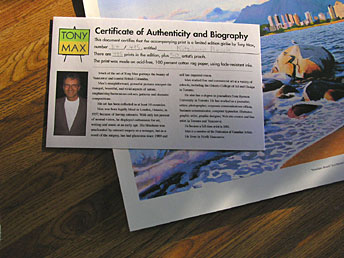| Introduction |
Art print |
|
| • High quality My limited edition inkjet prints are printed on archival canvas. The inks have been scientifically tested with the paper for lightfastness by Wilhelm Imaging Research, the world's leading researcher of archival inkjet lightfastness. |
 |
|
I sign and number every limited edition print. I also inspect each print before releasing it, thus ensuring that the print meets my exacting standards. Every print comes with a combined certificate of authenticity and biography, on which the following are documented:
Every certificate/biography bears the Tony Max logo. |
| Tips for Canvas Stretching |
| • For those customers who buy my prints unstretched and take them to picture framers, I offer the following tips, because some customers have asked me for advice and I've seen some professional picture framers that do a sloppy job of stretching canvases. • Phone around and ask the picture framers if they're competent and experienced at canvas stretching. Ask if they have samples of the canvases they've stretched for you to look at. • When you get to the frame shop, ask to see those samples. • Ask what kind of wood they use to fashion the stretcher bar sets that the canvas will be streched over. The wood should be good quality wood such as pine or fir, which doesn't warp as much as some other woods. • Larger picture should have at least one wooden brace, and for bigger pictures, two or three braces. • The staples should be stainless steel and rust-resistant. • I use stainless steel, rust-resistan staples that are one-quarter inch long. A large percentage of picture framers use regular staples that are not stainless steel and are not rust-resistant and they don't care that the staples will rust prematurely and stain the canvas that they're close to. • The staples should have tines that are short enough that they can be removed fairly easily. • Normally the sides are covered with black art tape, also known as gaffers' tape. • Tell the framer not to cut off (or cover with tape) the type I added to the canvas prints, which appears on the back of the canvas print after the prints has been stretched over wooden stretcher bars. The type has information that pertains to the print – the print's tiltle, size (small, medium, large, etcetera), dimensions, year of copyright, etcetera. • Another thing to look for is that the canvas should be as tight as a drum after it's been stretched. If canvas isn't properly stretched, it'll sag – especially at the corners. . |
Introduction |